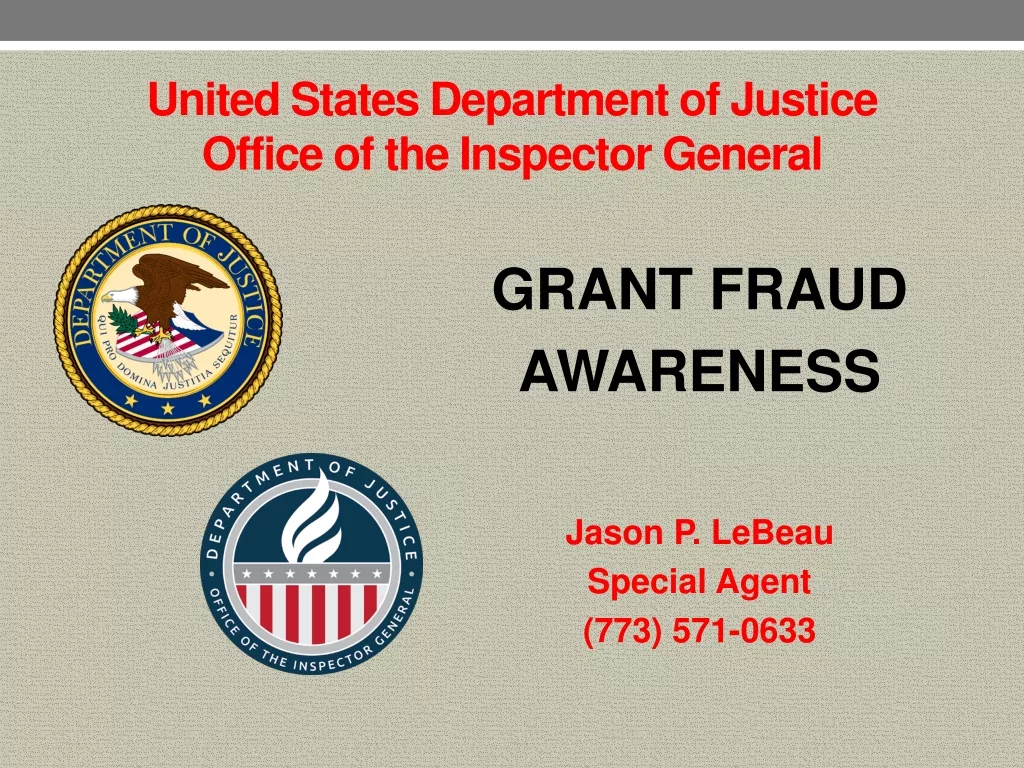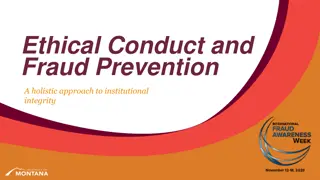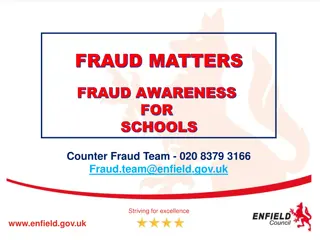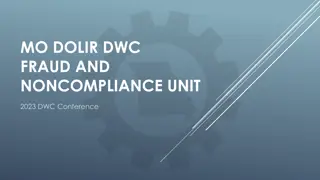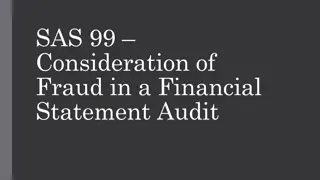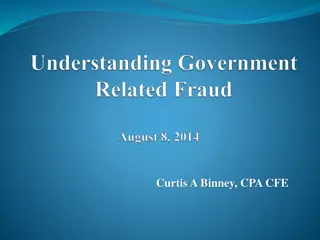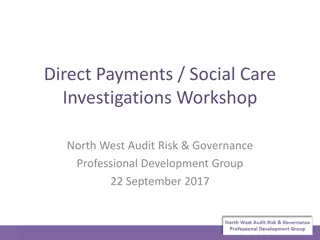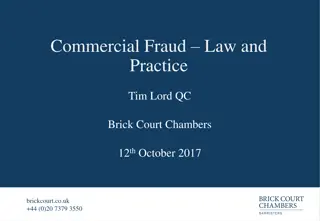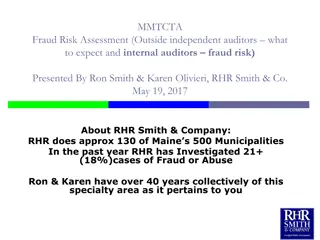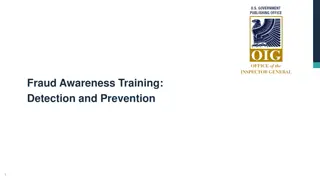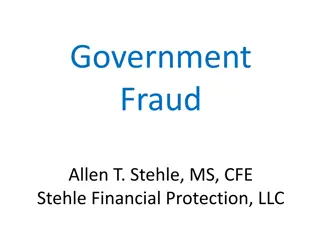New England Fraud Trends
Explore the latest trends in fraud in New England, including statistics, common types of cyber fraud, primary targets, and successful recovery efforts by the IC3 Recovery Asset Team. Discover key information on reporting incidents, victim demographics, and financial losses, with a focus on prominent cyber frauds like Business Email Compromise and Romance/Confidence Scams.
Download Presentation

Please find below an Image/Link to download the presentation.
The content on the website is provided AS IS for your information and personal use only. It may not be sold, licensed, or shared on other websites without obtaining consent from the author.If you encounter any issues during the download, it is possible that the publisher has removed the file from their server.
You are allowed to download the files provided on this website for personal or commercial use, subject to the condition that they are used lawfully. All files are the property of their respective owners.
The content on the website is provided AS IS for your information and personal use only. It may not be sold, licensed, or shared on other websites without obtaining consent from the author.
E N D
Presentation Transcript
New England Fraud Trends MAY 12, 2023
2021 IC3.GOV National Crime Statistics Total Victim Losses: $6.9 Billion Daily Reports Filed: 2,300 Largest Victim Demographic: Total Reports: Losses: Loss Increase Up From 2020: Individuals 60 and older 92,371 $1.68 Billion 74% 74% These statistics only account for incidents REPORTED to www.ic3.gov. These statistics only account for incidents REPORTED to www.ic3.gov.
IC3 Recovery Asset Team (RAT) 73% success rate in loss recovery Total Incidents: 2,838 $590.62 Million in Losses $433.30 Million Frozen * These figures only represent reported incidents that fall within certain criteria that trigger notification to the appropriate financial institution.
2021 IC3.GOV New England Statistics Total Victim Reports: 11,363 Total Victim Losses: $292.5 Million * Includes Maine, Massachusetts, New Hampshire and Vermont * Includes Maine, Massachusetts, New Hampshire and Vermont
Prominent Cyber Frauds Business Email Compromise (BEC/EAC) Romance/Confidence Scams Crypto Investment Malware Tech Support FI Account Compromise Elder Fraud (all encompassing)
Business Email Compromise Primary Targets: 1. Real estate closing entities such as title companies and attorneys 2. Healthcare institutions 3. Local municipalities 4. Businesses that regularly pay invoices to non-local/out of state contractors 5. Non-profits (e.g. Portland non-profit) New England 2021 Stats Reports filed: Victim Losses: $71.7 Million 720
Romance/Confidence Scams Primary Targets: 1. Divorcees 2. Widows and widowers 3. Socially/geographically isolated 4. Elderly New England 2021 Stats Reports Filed: 596 Victim Losses: $23.7 Million * This crime is highly under * This crime is highly under- -reported and is extremely common. extremely common. reported and is
Tech Support Primary Targets: 1. Elderly (46% of total victims; 69% of total loss) 2. High net worth individuals 3. Individuals with IRAs/retirement accounts New England 2021 Stats Reports Filed: 794 Victim Losses: $7.6 Million
Elder Fraud Elder fraud is an existential threat. National 2021 Stats Reports Filed: 88,262 Victim Losses: $3.1 Billion New England 2021 Stats * This is cyber-enabled/interstate fraud, and typically does not include relative/guardian- related elder fraud. Reports Filed: 2,672 Victim Losses: $103.2 Million
Why the rise in elder fraud? 1. The U.S. has seen a steady rise in our elderly population (15% currently; 20% by 2030) due to longer life span, better healthcare, growing wealth, etc. 2. The baby boomer generation prospered after World War II and amassed greater wealth than any prior generation. 3. Broad internet access and the proliferation of anonymizing apps give criminals the ability to reach across borders to victimize U.S. citizens. 4. Data breaches have exposed personal information, which is sold on the dark web. 5. Elderly are typically higher net worth, more trusting, less conflict adverse, and law abiding.
Elderly and Tech Support Numerous incidents of elderly victims in New England falling prey to tech support scams. These scams have recently increased in number and loss amount per incident Appear to be operating at a network level, to include call centers and money laundering networks Subjects use various tactics and tools, including external stimuli (loud alarms) and remote desktop software (to access victim computer and to mask IP logins) Common theme is convincing the victim that their financial institution is stealing from their accounts Victims withdraw funds from financial institution and deposit it into cryptocurrency accounts
Preventative Steps 1. Stay current and educate yourself regarding fraud schemes by visiting www.ic3.gov and www.usa.gov. 2. Regularly monitor your bank, investment, and credit accounts for unusual activity. 3. Freeze your credit (It s free!) 4. Do not answer calls from unknown telephone numbers and NEVER provide your personal information over the phone to unverified callers. 5. Stay active and engaged with family and community and relay unusual interactions to family and friends for a second opinion.
Wire Recall Procedure Knowing the wire recall process and being able to implement it quickly is imperative in order to recover victim funds. Steps to take if you are made aware of a fraudulent wire (IN THIS ORDER): 1. Immediately call your financial institution and request that it issue a wire recall notice to the recipient FI. 2. File a detailed complaint (to include all wire transfer info) on www.ic3.gov. This will initiate the financial fraud kill chain between the FBI and the recipient bank (dependent on timeframe and wire amount). 3. Contact the fraud department of recipient bank by telephone and email. 4. File local police report and obtain an incident number.
Questions? SA Andy Drewer FBI, Boston Division, Portland, Maine Resident Agency 100 Middle Street, West Tower, 4thFloor, Portland, ME 04101 Direct Line: 207-541-0705 Email: adrewer@fbi.gov * File reports via www.ic3.gov





